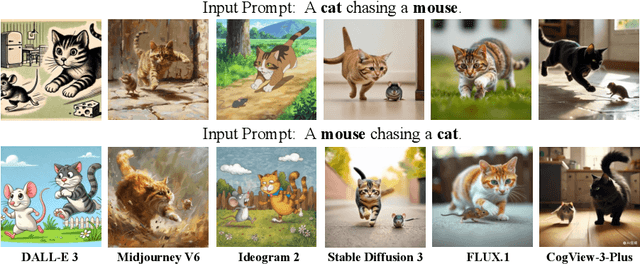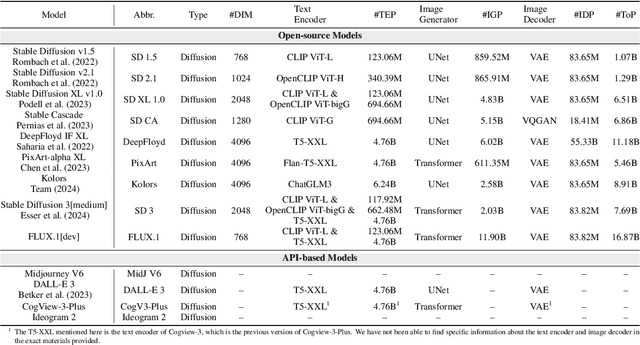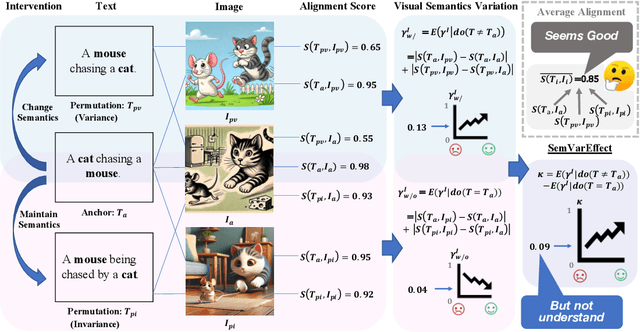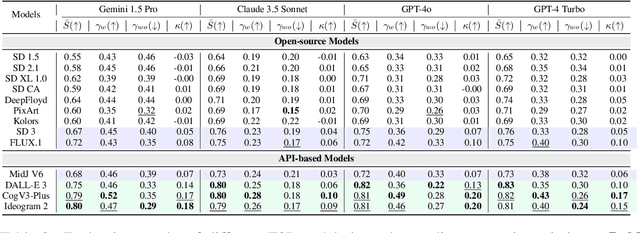Jun Huang
Understanding Attention Mechanism in Video Diffusion Models
Apr 16, 2025Abstract:Text-to-video (T2V) synthesis models, such as OpenAI's Sora, have garnered significant attention due to their ability to generate high-quality videos from a text prompt. In diffusion-based T2V models, the attention mechanism is a critical component. However, it remains unclear what intermediate features are learned and how attention blocks in T2V models affect various aspects of video synthesis, such as image quality and temporal consistency. In this paper, we conduct an in-depth perturbation analysis of the spatial and temporal attention blocks of T2V models using an information-theoretic approach. Our results indicate that temporal and spatial attention maps affect not only the timing and layout of the videos but also the complexity of spatiotemporal elements and the aesthetic quality of the synthesized videos. Notably, high-entropy attention maps are often key elements linked to superior video quality, whereas low-entropy attention maps are associated with the video's intra-frame structure. Based on our findings, we propose two novel methods to enhance video quality and enable text-guided video editing. These methods rely entirely on lightweight manipulation of the attention matrices in T2V models. The efficacy and effectiveness of our methods are further validated through experimental evaluation across multiple datasets.
Training Small Reasoning LLMs with Cognitive Preference Alignment
Apr 14, 2025Abstract:The reasoning capabilities of large language models (LLMs), such as OpenAI's o1 and DeepSeek-R1, have seen substantial advancements through deep thinking. However, these enhancements come with significant resource demands, underscoring the need to explore strategies to train effective reasoning LLMs with far fewer parameters. A critical challenge is that smaller models have different capacities and cognitive trajectories than their larger counterparts. Hence, direct distillation of chain-of-thought (CoT) results from large LLMs to smaller ones can be sometimes ineffective and requires a huge amount of annotated data. In this paper, we introduce a novel framework called Critique-Rethink-Verify (CRV), designed for training smaller yet powerful reasoning LLMs. Our CRV framework consists of multiple LLM agents, each specializing in unique abilities: (i) critiquing the CoTs according to the cognitive capabilities of smaller models, (ii) rethinking and refining these CoTs based on the critiques, and (iii) verifying the correctness of the refined results. We further propose the cognitive preference optimization (CogPO) algorithm to enhance the reasoning abilities of smaller models by aligning thoughts of these models with their cognitive capacities. Comprehensive evaluations on challenging reasoning benchmarks demonstrate the efficacy of CRV and CogPO, which outperforms other training methods by a large margin.
AirVista-II: An Agentic System for Embodied UAVs Toward Dynamic Scene Semantic Understanding
Apr 13, 2025Abstract:Unmanned Aerial Vehicles (UAVs) are increasingly important in dynamic environments such as logistics transportation and disaster response. However, current tasks often rely on human operators to monitor aerial videos and make operational decisions. This mode of human-machine collaboration suffers from significant limitations in efficiency and adaptability. In this paper, we present AirVista-II -- an end-to-end agentic system for embodied UAVs, designed to enable general-purpose semantic understanding and reasoning in dynamic scenes. The system integrates agent-based task identification and scheduling, multimodal perception mechanisms, and differentiated keyframe extraction strategies tailored for various temporal scenarios, enabling the efficient capture of critical scene information. Experimental results demonstrate that the proposed system achieves high-quality semantic understanding across diverse UAV-based dynamic scenarios under a zero-shot setting.
A Short Survey on Small Reasoning Models: Training, Inference, Applications and Research Directions
Apr 12, 2025Abstract:Recently, the reasoning capabilities of large reasoning models (LRMs), such as DeepSeek-R1, have seen significant advancements through the slow thinking process. Despite these achievements, the substantial computational demands of LRMs present considerable challenges. In contrast, small reasoning models (SRMs), often distilled from larger ones, offer greater efficiency and can exhibit distinct capabilities and cognitive trajectories compared to LRMs. This work surveys around 170 recently published papers on SRMs for tackling various complex reasoning tasks. We review the current landscape of SRMs and analyze diverse training and inference techniques related to SRMs. Furthermore, we provide a comprehensive review of SRMs for domain-specific applications and discuss possible future research directions. This survey serves as an essential reference for researchers to leverage or develop SRMs for advanced reasoning functionalities with high efficiency.
Beyond Existance: Fulfill 3D Reconstructed Scenes with Pseudo Details
Mar 06, 2025Abstract:The emergence of 3D Gaussian Splatting (3D-GS) has significantly advanced 3D reconstruction by providing high fidelity and fast training speeds across various scenarios. While recent efforts have mainly focused on improving model structures to compress data volume or reduce artifacts during zoom-in and zoom-out operations, they often overlook an underlying issue: training sampling deficiency. In zoomed-in views, Gaussian primitives can appear unregulated and distorted due to their dilation limitations and the insufficient availability of scale-specific training samples. Consequently, incorporating pseudo-details that ensure the completeness and alignment of the scene becomes essential. In this paper, we introduce a new training method that integrates diffusion models and multi-scale training using pseudo-ground-truth data. This approach not only notably mitigates the dilation and zoomed-in artifacts but also enriches reconstructed scenes with precise details out of existing scenarios. Our method achieves state-of-the-art performance across various benchmarks and extends the capabilities of 3D reconstruction beyond training datasets.
Renewable Energy Prediction: A Comparative Study of Deep Learning Models for Complex Dataset Analysis
Jan 27, 2025Abstract:The increasing focus on predicting renewable energy production aligns with advancements in deep learning (DL). The inherent variability of renewable sources and the complexity of prediction methods require robust approaches, such as DL models, in the renewable energy sector. DL models are preferred over traditional machine learning (ML) because they capture complex, nonlinear relationships in renewable energy datasets. This study examines key factors influencing DL technique accuracy, including sampling and hyperparameter optimization, by comparing various methods and training and test ratios within a DL framework. Seven machine learning methods, LSTM, Stacked LSTM, CNN, CNN-LSTM, DNN, Time-Distributed MLP (TD-MLP), and Autoencoder (AE), are evaluated using a dataset combining weather and photovoltaic power output data from 12 locations. Regularization techniques such as early stopping, neuron dropout, L1 and L2 regularization are applied to address overfitting. The results demonstrate that the combination of early stopping, dropout, and L1 regularization provides the best performance to reduce overfitting in the CNN and TD-MLP models with larger training set, while the combination of early stopping, dropout, and L2 regularization is the most effective to reduce the overfitting in CNN-LSTM and AE models with smaller training set.
UAVs Meet LLMs: Overviews and Perspectives Toward Agentic Low-Altitude Mobility
Jan 04, 2025Abstract:Low-altitude mobility, exemplified by unmanned aerial vehicles (UAVs), has introduced transformative advancements across various domains, like transportation, logistics, and agriculture. Leveraging flexible perspectives and rapid maneuverability, UAVs extend traditional systems' perception and action capabilities, garnering widespread attention from academia and industry. However, current UAV operations primarily depend on human control, with only limited autonomy in simple scenarios, and lack the intelligence and adaptability needed for more complex environments and tasks. The emergence of large language models (LLMs) demonstrates remarkable problem-solving and generalization capabilities, offering a promising pathway for advancing UAV intelligence. This paper explores the integration of LLMs and UAVs, beginning with an overview of UAV systems' fundamental components and functionalities, followed by an overview of the state-of-the-art in LLM technology. Subsequently, it systematically highlights the multimodal data resources available for UAVs, which provide critical support for training and evaluation. Furthermore, it categorizes and analyzes key tasks and application scenarios where UAVs and LLMs converge. Finally, a reference roadmap towards agentic UAVs is proposed, aiming to enable UAVs to achieve agentic intelligence through autonomous perception, memory, reasoning, and tool utilization. Related resources are available at https://github.com/Hub-Tian/UAVs_Meet_LLMs.
Building a Family of Data Augmentation Models for Low-cost LLM Fine-tuning on the Cloud
Dec 06, 2024



Abstract:Specializing LLMs in various domain-specific tasks has emerged as a critical step towards achieving high performance. However, the construction and annotation of datasets in specific domains are always very costly. Apart from using superior and expensive closed-source LLM APIs to construct datasets, some open-source models have become strong enough to handle dataset construction in many scenarios. Thus, we present a family of data augmentation models designed to significantly improve the efficiency for model fine-tuning. These models, trained based on sufficiently small LLMs, support key functionalities with low inference costs: instruction expansion, instruction refinement, and instruction-response pair expansion. To fulfill this goal, we first construct an automatic data collection system with seed datasets generated from both public repositories and our in-house datasets. This system leverages powerful LLMs to expand, refine and re-write the instructions and responses, incorporating quality assessment techniques. Following this, we introduce the training process of our models, which effectively distills task-solving and text synthesis abilities from teacher LLMs. Finally, we demonstrate how we integrate these functionalities into a machine learning platform to support low-cost LLM fine-tuning from both dataset preparation and training perspectives for users. Experiments and an application study prove the effectiveness of our approach.
An Open API Architecture to Discover the Trustworthy Explanation of Cloud AI Services
Nov 05, 2024



Abstract:This article presents the design of an open-API-based explainable AI (XAI) service to provide feature contribution explanations for cloud AI services. Cloud AI services are widely used to develop domain-specific applications with precise learning metrics. However, the underlying cloud AI services remain opaque on how the model produces the prediction. We argue that XAI operations are accessible as open APIs to enable the consolidation of the XAI operations into the cloud AI services assessment. We propose a design using a microservice architecture that offers feature contribution explanations for cloud AI services without unfolding the network structure of the cloud models. We can also utilize this architecture to evaluate the model performance and XAI consistency metrics showing cloud AI services trustworthiness. We collect provenance data from operational pipelines to enable reproducibility within the XAI service. Furthermore, we present the discovery scenarios for the experimental tests regarding model performance and XAI consistency metrics for the leading cloud vision AI services. The results confirm that the architecture, based on open APIs, is cloud-agnostic. Additionally, data augmentations result in measurable improvements in XAI consistency metrics for cloud AI services.
* Published in: IEEE Transactions on Cloud Computing ( Volume: 12, Issue: 2, April-June 2024)
Evaluating Semantic Variation in Text-to-Image Synthesis: A Causal Perspective
Oct 14, 2024



Abstract:Accurate interpretation and visualization of human instructions are crucial for text-to-image (T2I) synthesis. However, current models struggle to capture semantic variations from word order changes, and existing evaluations, relying on indirect metrics like text-image similarity, fail to reliably assess these challenges. This often obscures poor performance on complex or uncommon linguistic patterns by the focus on frequent word combinations. To address these deficiencies, we propose a novel metric called SemVarEffect and a benchmark named SemVarBench, designed to evaluate the causality between semantic variations in inputs and outputs in T2I synthesis. Semantic variations are achieved through two types of linguistic permutations, while avoiding easily predictable literal variations. Experiments reveal that the CogView-3-Plus and Ideogram 2 performed the best, achieving a score of 0.2/1. Semantic variations in object relations are less understood than attributes, scoring 0.07/1 compared to 0.17-0.19/1. We found that cross-modal alignment in UNet or Transformers plays a crucial role in handling semantic variations, a factor previously overlooked by a focus on textual encoders. Our work establishes an effective evaluation framework that advances the T2I synthesis community's exploration of human instruction understanding.
 Add to Chrome
Add to Chrome Add to Firefox
Add to Firefox Add to Edge
Add to Edge